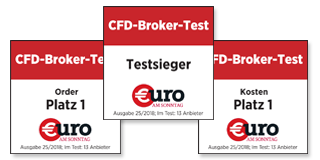Test NanoTrader Full I Test Tradingview I Test the mobile platforms All for CFD-Forex & Futures
You are here
Book Review – How to Make Money in Stocks
This book, written by William J. O'Neil, is a “modern classic” of the trading literature. Since its first publication in 1988, it has been published several times in a new, updated edition. This review refers to the 2011 version.

"How to Make Money in Stocks" is divided into 3 major sections.
1. THE MOST IMPORTANT PART
The first section is the most important and covers just under half of the book. First, basic trading principles are derived from the largest winning stocks in the history of the US stock market. On almost 100 pages, many historical chart examples with corresponding signals and comments are shown. O'Neil emphasizes that charts are essential to successful trading and that you can draw conclusions from the patterns of past success stories. The reason for this is that neither human nature nor the laws of supply and demand have changed.
The first section also describes the individual components of still today's popular CANSLIM strategy. These can be summarized as follows:
C = Current Big or Accelerating Quarterly Earnings Per Share: The company should show significant earnings growth compared to the same quarter last year; the higher the better.
A = Annual Earnings Increases: A single good quarterly profit can turn out to be a straw fire in hindsight. To exclude this, the annual profit growth should be as high as possible.
N = New Product, New Enterprise or New Service: Investors should look for companies that are developing significant new products. Innovative companies with completely new products can grow fast and with high profit margins.
S = Supply and Demand: When a stock goes up, it is usually positive to see the price increase accompanied by higher volume. A chart breakout from a consolidation formation should have a volume increase that is about 40-50 percent above normal levels.
L = Leader or Laggard: Investors should buy the leaders of an industry whose stock prices are high in Relative Strength and lead the sector movement. Market leaders usually have the highest operating margins and are quickly gaining market share.
I = Institutional Sponsorship: It is positive for equities when more and more funds and institutional investors buy into a stock and the number of investors increases quarter by quarter.
M = Market Direction: The best analysis of a stock according to the above criteria is of little use if the overall market is in a bear phase and falls sharply. Therefore one should determine the market direction based on moving averages, leading stocks and distribution days and invest only in bull markets.
2. DEFINITELY RELEVANT
The second section deals with closing positions in case of profit and loss, risk management and the most common mistakes. Crucial to success is first of all to have a strong defense in the case of losing trades. That means selling in time at a 7-8% threshold before the losses get too big. Conversely, for the strongest winning stocks, O'Neil advocates continuing to build up positions in a degressive fashion. The combination of both makes it possible to follow the old mantra of “cutting losses and letting profits run”. As far as closing positions in case of profit, it is better to sell too early than too late. Accordingly, it makes sense to aim for price increases of at least 20% and sell positions into the strength, if the trade lasted longer than the minimum holding period of 8 weeks. The book also describes technical exit signals such as the Climax Top.
The opinion of a trader on the NanoTrader trading platform offered by broker WH SELFINVEST...
This trading platform is simply genious. You can immediately find your way around. The range of tradable instruments is exceptional. The support folk are competent, friendly and fast. I could go on like this for hours. Really first class. – C.B.
Make a quantum leap in your trading... download a free real-time NanoTrader demo.
3. A BIT THIN
The content in the third section is, unfortunately, a bit thin. At first, further chart patterns as well as sector analysis is presented. Then it explains how services from Investor's Business Daily can be used, which is quite a promotional section. Later on, there is a chapter with tips on market observation and about how to react to news. The best part of the third section is the last 3 pages with summarized trading rules and hints.
4. CONCLUSION
The biggest value added of the book lies in the description of the CANSLIM criteria as well as the many historical chart examples. O'Neil advocates holding few well-selected stocks and “paying close attention” to them instead of diversifying across the board, ultimately only achieving mediocre results. The book concludes with a bonus chapter where you can test your knowledge.
The 10 main findings from the book:
- To get into big winning stocks, buy stocks on the rise (rather than stocks on the fall).
- Bullish price patterns and chart bases offer the best chances for successful breakouts.
- The best chart pattern is the cup-and-handle formation.
- Do not trade intraday and do not try to read the tape.
- Do not buy stocks based on hot tips or rumors.
- Always check buying ideas for the weekly chart in order to check its relative price level.
- Avoid hard stops that will throw you out of position at the most unfavorable moment.
- Short positions are very risky and only interesting in confirmed bear markets.
- In case of a winning trade, sell into strength (rather than selling too late).
- In case of a losing position, get out in time (at a 7-8% loss).
€uro am Sonntag broker test result:
„The lowest price broker. The best order execution.“
The respected finance magazine "€uro am Sonntag" tested 13 CFD-Forex broker on 733 criteria. In this wide-ranging test of the brokerage industry broker WH SELFINVEST came in first, once more.

Visit broker WH SELFINVEST: offices in France, Germany, Belgium, Luxemburg, the Netherlands and Switzerland.



